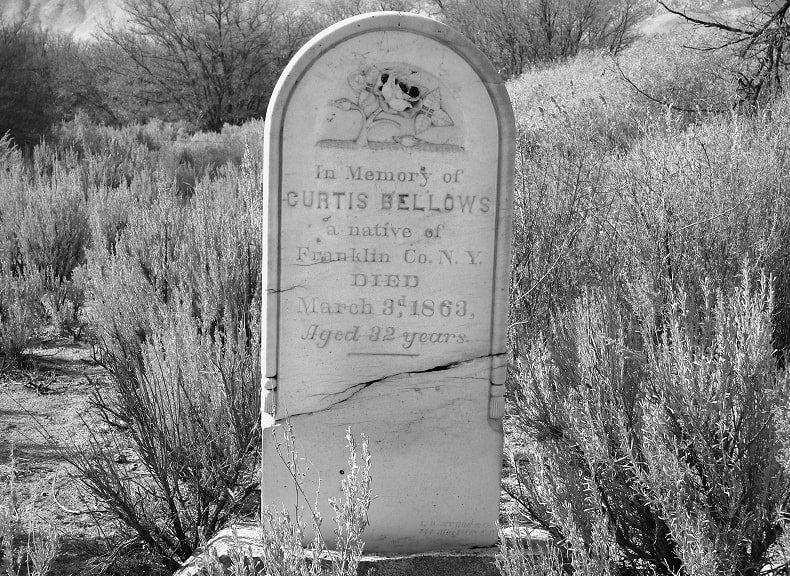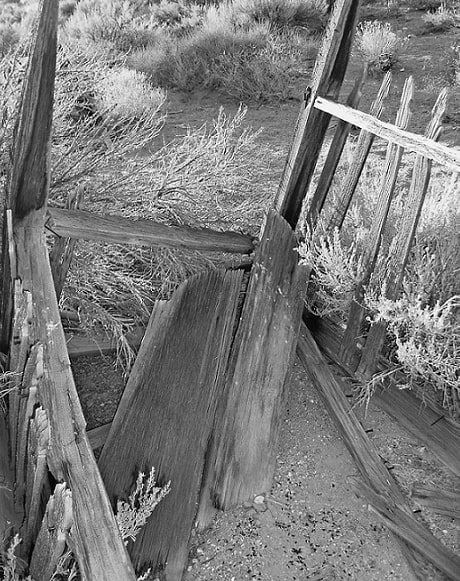Introduction: In this article, Gena Philibert-Ortega provides genealogy tips for researching cemeteries that she learned while writing a book on cemeteries in eastern California. Gena is a genealogist and author of the book “From the Family Kitchen.”
In 2007 I wrote a book titled Cemeteries of the Eastern Sierra (Arcadia Publishing) that focused on the images and history of cemeteries in the Eastern Sierra region of California. This required a lot of research in various repositories online and off, as well as the cemeteries themselves. That experience taught me a lot about cemeteries and what mistakes we genealogists make in searching for our ancestors.

Not Everyone’s Grave Is Marked
While we would like to easily find our ancestor’s final resting place well marked, that’s not always the reality. Not everyone had a gravestone and that, unfortunately, is still true today.
The cost associated with final burial arrangements is expensive, and that was even true for our ancestors. Gravestones can be expensive and not everyone’s family can afford one. They might have delayed marking the grave thinking they would eventually get around to it – and instead life got in the way.
It’s also important to remember that not everyone leaves family behind. No close family, or being the person who outlives everyone else, may mean that no one is around to take care of the final details.
Add to that the fact that gravestones can be stolen or destroyed over time. Wooden markers don’t last, and some stone markers don’t always wear well in the elements. When I was writing my book, thieves were stealing the metal inserts from some markers and selling them to metal recyclers. So, if your ancestor’s grave is marked, consider yourself lucky.

Not All Cemeteries Are the Same
Visualize a cemetery. What do you see? Maybe a nice manicured lawn with neat rows of gravestones all lined up. That’s one type of cemetery, but there are others. Cemeteries are different. Yes, there are those beautiful manicured cemeteries – but there are also cemeteries that are forgotten and overgrown. Cemetery types include:
- City Cemetery
- Ethnic Cemetery
- Fraternal Lodge Cemetery
- Mass Burial Site
- Religious Cemetery
- Private Cemetery
- Military Cemetery
- Family Cemetery
Information Changes over Time
When I started my research, the online sources we have today existed, but they were still new. I had to do research the “old fashioned way.” That meant going to the FamilySearch website and conducting a Catalog search to find cemetery transcriptions. Though today we have online options, I still recommend this approach. Why?
In my opinion there are two reasons to combine your online search with old research methodologies. Probably the biggest reason is that not everything is online. Second, things change over time and cemeteries definitely change. As I mentioned previously, tombstones can be stolen or worn with age. Older transcriptions found through FamilySearch or other resources can help you get an idea of that cemetery in that place in time. Which means you might find listings that today you won’t find because the gravestone is illegible or gone.
One last thing. Don’t forget about searching for that cemetery in old newspapers such as GenealogyBank’s Historical Newspaper Archives. You already know that an ancestor’s obituary may include cemetery information. Newspapers can also provide information about the history of that cemetery, which in turn might help explain why you can’t find a burial.
Ready for Some Cemetery Research?
Cemetery research is much more than just taking a drive and snapping some photos of your ancestor’s final resting place. Like all research it can be met with obstacles. Don’t make assumptions about your ancestor’s burial, and make sure to do your homework ahead of time.
Unfortunately, even if you adhere to that advice you still may not find what you’re looking for. However, thorough genealogical research into your ancestor’s burial can help you find answers or at least narrow the search.
Related Articles:

Good ideas.
Thanks Myra! I appreciate it!
Gena,
I can appreciate your comments here. I did research on our hometown cemetery for nearly ten years. When I started, I found no other books on how to research and restore a historic cemetery. My work included on-site archeological work, on- and off-line research, and a lot of trial and error. I wrote a book about my research that includes stories of people buried there. I included a chapter on how to do the mapping and archeological work. Of the 70 graves whose locations were unknown when I started, I have located only 11. Your mention of digitized newspapers as valuable resources is true. One of the graves I located was described this way in a newspaper: “Davey O’Conner was buried next to his friend Mike Flatly.” Mike Flatly’s grave was marked. My work also included surveying and creating a map of the cemetery.
David, that sounds like a fabulous project. I like how you used archeology in your work. Thank you for sharing that.–Gena
I would love to write a book or something for my family of where people are buried. I’m not sure how to start or where; hoping you might give me some information. Also do you include a drawing or map along with the name of the cemetery?
Kathy, If you are just focusing on burial I would probably do a small history of the cemetery and then include everyone who is buried there and their information. You could add a map or images of the cemetery and the gravestones. That would help if the readers want to find the burials. It would be a good idea to conduct some research on the person’s death so you can also explain that. You could do this by getting their death certificates, any cemetery or funeral home records, and the obituaries. Historical newspapers would be good for history on the cemetery as well. Good luck!–Gena
Cemeteries are also lost to construction and, if lucky, the graves were moved beforehand. However, in most cases, it is up to the family to pay to have the marker, if any, moved. Although many cemeteries have “sections,” they are not always clearly marked. It may have started out placing section markers but, over time, stopped for any number of reasons.
Susan, you’re absolutely right. That’s why looking at the history of the cemetery or the area can help. I also use older transcriptions because in some cases the markers are missing.
My husband’s great grandmother had a marker but her husband didn’t. I do photos for FindAGrave and I just hate having to tell someone that yes the cemetery office told you the right lot number but there’s no stone marking the grave. Cemetery records -– whether in book form or online –- usually only tell you what the cemetery records say but that doesn’t always mean there’s a stone. In our case I contacted all the great grandchildren and purchased a stone for great grandfather.
Mary, death today and in our ancestors’ time is/was expensive, and sometimes there’s no money for a marker or no family to purchase it. I’m so glad you were able to gather the descendants together to purchase one. What a wonderful thing to do. Thanks for the volunteer work you do!–Gena